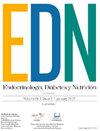手测力:测量所用的装置重要吗?
IF 1.8
4区 医学
Q4 ENDOCRINOLOGY & METABOLISM
引用次数: 0
摘要
介绍:握力计通过优势手的握力来测量肌肉力量。本研究的目的是比较Dynx, Saehan和Smedlay测功机与Jamar测功机(金标准),通过评估其测量的相关性和一致性来确定使用不同的测功机是否无关。材料和方法:在2020 - 2021年间进行横断面研究。我们评估了一组来自内分泌和营养咨询的患者(GP)和一组卫生人员的对照组(CG)。用四种不同的测力仪(Jamar, Dynx, Saehan和Smedlay)按随机顺序测量优势手握力。统计分析采用SPSS进行,采用学生t检验、类内相关系数(ICC)和Bland-Altman图。结果:共纳入124名受试者;91名GP(60.4%为女性),平均年龄54.9岁(SD14.2)岁。ICC与GP相关性最佳(0.977 p)本文章由计算机程序翻译,如有差异,请以英文原文为准。
Hand dynamometry: Does the device used for measurement matter?
Introduction
Handgrip dynamometers measure muscle strength through the grip strength of the dominant hand. The purpose of this study is to compare the Dynx, Saehan, and Smedlay dynamometers with the Jamar dynamometer (gold standard) by evaluating the correlation and concordance of their measurements to determine if it is indifferent to use different dynamometers.
Material and methods
Cross-sectional study conducted between 2020 and 2021.
We evaluated a group of patients (GP) from the Endocrinology and Nutrition consultations and a control group (CG) of health personnel.
Dominant hand grip strength was measured with four different dynamometers Jamar, Dynx, Saehan and Smedlay, in random order. Statistical analysis was performed with SPSS using Student's t-test, intraclass correlation coefficient (ICC), and Bland-Altman plots.
Results
A total of 124 subjects were included; 91 GP (60.4% women), mean age 54.9 (SD14.2) years. ICC showed the best correlation for Saehan in GP (0.977 p < 0.001) and in GC (0.960 p < 0.001). Dynx correlated better in GP than in GC (0.967 vs. 0.900, p < 0.001) and Smedlay had the worst correlation in GC (0.812 p < 0.001). The dynamometer with the lowest bias (-0.39, SD 3.11) and better limits of agreement (LOA) in both groups (GP -0.39, GC -0.51) was the Saehan
Conclusion
Despite good measurement correlation, there is bias and insufficient agreement between different dynamometers, so they should not be used interchangeably.
求助全文
通过发布文献求助,成功后即可免费获取论文全文。
去求助
来源期刊

Endocrinologia Diabetes Y Nutricion
Multiple-
CiteScore
2.10
自引率
10.50%
发文量
99
期刊介绍:
Endocrinología, Diabetes y Nutrición is the official journal of the Spanish Society of Endocrinology and Nutrition (Sociedad Española de Endocrinología y Nutrición, SEEN) and the Spanish Society of Diabetes (Sociedad Española de Diabetes, SED), and was founded in 1954.
The aim of the journal is to improve knowledge and be a useful tool in practice for clinical and laboratory specialists, trainee physicians, researchers, and nurses interested in endocrinology, diabetes, nutrition and related disciplines.
It is an international journal published in Spanish (print and online) and English (online), covering different fields of endocrinology and metabolism, including diabetes, obesity, and nutrition disorders, as well as the most relevant research produced mainly in Spanish language territories.
The quality of the contents is ensured by a prestigious national and international board, and by a selected panel of specialists involved in a rigorous peer review. The result is that only manuscripts containing high quality research and with utmost interest for clinicians and professionals related in the field are published.
The Journal publishes Original clinical and research articles, Reviews, Special articles, Clinical Guidelines, Position Statements from both societies and Letters to the editor.
Endocrinología, Diabetes y Nutrición can be found at Science Citation Index Expanded, Medline/PubMed and SCOPUS.
 求助内容:
求助内容: 应助结果提醒方式:
应助结果提醒方式:


